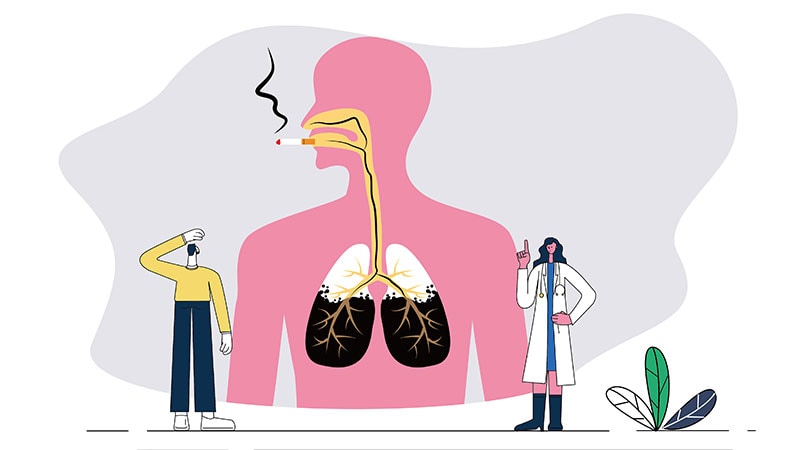The rise of invasive fungal infections explained
The article highlights the overlooked issue of invasive fungal infections, which can be life-threatening, especially for immunocompromised individuals. Their rise is linked to medical procedures and antifungal resistance. The article stresses the importance of raising awareness and developing effective treatments for this growing public health concern.

You probably know about athlete's foot and yeast infections — right now up to 1 in 4 people have athlete's foot across the globe, while 3 in 4 women will develop a vaginal yeast infection in their lifetime. But these well-known infections are only the tip of the fungal iceberg.
Although you may be aware of fungal skin infections, you may not be aware of "invasive" fungal infections, which can affect your lungs or spread to your organs through your blood.
These infections are on the rise and can be life-threatening, especially in immunocompromised people. For years, they have fallen under the radar of the general public. It was only last year that the World Health Organization released its first-ever list of health-threatening fungi.
This general lack of awareness has led to misdiagnosis of fungal infections in clinical settings and stymied development of medications to treat the problem.
It also makes it impossible for the WHO to conclusively estimate the burden of disease. Experts suggest invasive fungal infections kill up to 1.5 million people per year — for reference, that's around the number of deaths attributed to tuberculosis per year.
The Candida fungus can cause invasive fungal infectionsImage: La Nacion/ZUMA Press/picture-alliance
How do you "catch" an invasive fungal infection?
We breathe in spores of fungus all the time. This fungus comes from our compost bins, the moldy bread on our kitchen table or the flower bulbs we plant in our gardens (more on that later).
Oliver Cornely, head of the European Center of Excellence for Invasive Fungal Infections, said these spores aren't a problem for the vast majority of healthy people, whose immune systems can easily fight them off.
But for the immunocompromised — those who smoke very heavily or have recently experienced an organ transplant or cellular therapy — inhaling these spores can sometimes cause problems.
Why are invasive fungal infections on the rise?
Cornely said the rise in invasive fungal infections is largely linked to a rising number of life saving operations.
Today, many more people routinely undergo operations and treatments, such as chemotherapy. But such medical interventions can increase a person's susceptibility to invasive fungal infections,
There's also an increasing issue with antifungal resistance.
What is antifungal resistance and why is it a problem?
Antifungal resistance is like antibiotic resistance. Some fungi are resistant to the medications, or antifungals, used to treat them.
Some fungi are intrinsically resistant to certain classes of antifungals, said Cornely.
Others become resistant to antifungals because a smaller dose reaches them, allowing them to become resistant to, rather than annihilated by, the medication.
One way to understand this is to think about peanut allergy treatments. People with a peanut allergy eat a tiny amount over a period of time to build up resistance. Eventually they become immune to the allergens in peanuts.
This is similar to fungi — when fungi are exposed to tiny doses of antifungals, they can build up resistance.
This resistance can be built within the body of a person being treated with antifungals or in nature — antifungals are used in bulk in agriculture. The United Nations Food and Agriculture Organization estimates that if antifungals were to stop being used in farming, we would lose food for 2 billion people.
"It's a dilemma," Cornely said. "We must use them in agriculture. We should not really use them for flower bulbs, though."
How are antifungals used in agriculture?
Antifungals are used on flower bulbs for the same reasons they are used in food production: to prevent you from picking up a daffodil bulb at the florist and finding a big piece of mold on it.
Before flower bulbs are sold at a nursery, they undergo something called "bulb dipping" into a bath of azoles, the same antifungal agent used to treat invasive fungal infections.
Candida auris could have developed in response to global warming, experts sayImage: Kateryna Kon/IMAGO
"That is why when you go to the garden center, you never find a bulb with fungus," Cornely said. "Usually, like your bread, these things should really decay and be destroyed by Aspergillus fumigators … but that does not happen because they are covered with azoles."
That may all be fine and good — no one wants to deal with moldy flowers! But Cornely said that what happens is that when you take the bulbs home and plant them in your garden, the azoles enter the soil. This results in a high concentration of azoles directly next to the bulb, but as you get farther and farther away, the concentration lessens until it is so low that fungi in the soil can tolerate it — just like the tiny portions of peanuts people eat to treat an allergy. Through this exposure, those fungi become resistant to the azoles.
This is the same thing that happens when an antifungal is used to treat an abscess, Cornely said. In the abscess itself and directly near it, the amount of antifungal will be so strong, it will kill all fungi in its path. But the farther and farther away, the lower the concentration of the antifungal, the higher the likelihood the fungi in the body will become resistant to, rather than die from, this exposure.
Which invasive fungal infections are most common?
The most common invasive fungal infections are caused by the Candida and Aspergillus fungi. Aspergillus primarily affects the lung, while Candida can spread through the bloodstream to cause infection in different organs of the body, most commonly the eyes, bones, liver or spleen.
Cornely said this can happen from the gastrointestinal tract. In healthy people, he said, it's normal to have fungus there "hanging around with myriads of bacteria."
But in people who have undergone procedures or health issues affecting the integrity of their mucosa — the soft tissue that lines our organs, protecting them against invasive pathogens — these fungal organisms can become pathogens themselves.
What is Your Reaction?
 Like
0
Like
0
 Dislike
0
Dislike
0
 Love
0
Love
0
 Funny
0
Funny
0
 Angry
0
Angry
0
 Sad
0
Sad
0
 Wow
0
Wow
0












































































